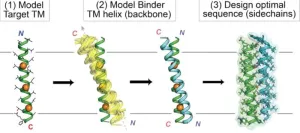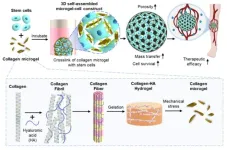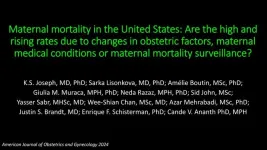(Press-News.org) A four-year study by Dartmouth researchers captures the most in-depth data yet on how college students' self-esteem and mental health fluctuates during their four years in academia, identifying key populations and stressors that the researchers say administrators could target to improve student well-being.
The study also provides among the first real-time accounts of how the coronavirus pandemic affected students' behavior and mental health. The stress and uncertainty of COVID-19 resulted in long-lasting behavioral changes that persisted as a "new normal" even as the pandemic diminished, including feeling more stressed, less socially engaged, and sleeping more.
The researchers tracked more than 200 Dartmouth undergraduates in the classes of 2021 and 2022 for all four years of college. Students volunteered to let a specially developed app called StudentLife tap into the sensors that are built into smartphones. The app cataloged their daily physical and social activity, how long they slept, their location and travel, the time they spent on their phone, and how often they listened to music or videos. Students also filled out weekly behavioral surveys, and selected students gave post-study interviews.
The study—which is the longest mobile-sensing study ever conducted—is published in the Proceedings of the ACM on Interactive, Mobile, Wearable and Ubiquitous Technologies. The researchers will present it at the Association of Computing Machinery's UbiComp/ISWC 2024 conference in Melbourne, Australia, in October. The team made their anonymized data set publicly available—including self-reports, surveys, and phone-sensing and brain-imaging data—to help advance research into the mental health of students during their college years.
Andrew Campbell, the paper's senior author and Dartmouth's Albert Bradley 1915 Third Century Professor of Computer Science, said that the study's extensive data reinforces the importance of college and university administrators across the country being more attuned to how and when students' mental well-being changes during the school year.
"For the first time, we've produced granular data about the ebb and flow of student mental health. It's incredibly dynamic—there's nothing that's steady state through the term, let alone through the year," he said. "These sorts of tools will have a tremendous impact on projecting forward and developing much more data-driven ways to intervene and respond exactly when students need it most."
First-year and female students are especially at risk for high anxiety and low self-esteem, the study finds. Among first-year students, self-esteem dropped to its lowest point in the first weeks of their transition from high school to college but rose steadily every semester until it was about 10% higher by graduation.
"We can see that students came out of high school with a certain level of self-esteem that dropped off to the lowest point of the four years. Some said they started to experience 'imposter syndrome' from being around other high-performing students," Campbell said. "As the years progress, though, we can draw a straight line from low to high as their self-esteem improves. I think we would see a similar trend class over class. To me, that's a very positive thing."
Female students—who made up 60% of study participants—experienced on average 5% greater stress levels and 10% lower self-esteem than male students. More significantly, the data show that female students tended to be less active, with male students walking 37% more often.
Sophomores were 40% more socially active compared to their first year, the researchers report. But these students also reported feeling 13% more stressed than during their first year as their workload increased, they felt pressure to socialize, or as first-year social groups dispersed.
One student in a sorority recalled that having pre-arranged activities "kind of adds stress as I feel like I should be having fun because everyone tells me that it is fun." Another student noted that after the first year," students have more access to the whole campus and that is when you start feeling excluded from things."
In a novel finding, the researchers identify an "anticipatory stress spike" of 17% experienced in the last two weeks of summer break. While still lower than mid-academic year stress, the spike was consistent across different summers.
In post-study interviews, some students pointed to returning to campus early for team sports. Others specified reconnecting with family and high school friends during their first summer home, saying they felt "a sense of leaving behind the comfort and familiarity of these long-standing friendships" as the break ended, the researchers report.
"This is a foundational study," said Subigya Nepal, first author of the study and a PhD candidate in Campbell's research group. "It has more real-time granular data than anything we or anyone else has provided before. We don't know yet how it will translate to campuses nationwide, but it can be a template for getting the conversation going."
The depth and accuracy of the study data suggest that mobile-sensing software could eventually give universities the ability to create proactive mental-health policies specific to certain student populations and times of year, Campbell said.
For example, a paper Campbell's research group published in 2022 based on StudentLife data showed that first-generation students experienced lower self-esteem and higher levels of depression than other students throughout their four years of college.
"We will be able to look at campus in much more nuanced ways than waiting for the results of an annual mental health study and then developing policy," Campbell said. "We know that Dartmouth is a small and very tight-knit campus community. But if we applied these same methods to a college with similar attributes, I believe we would find very similar trends."
Weathering the pandemic
When students returned home at the start of the coronavirus pandemic, the researchers found that self-esteem actually increased during the pandemic by 5% overall and by another 6% afterward when life returned closer to what it was before. One student suggested in their interview that getting older came with more confidence. Others indicated that being home led to them spending more time with friends talking on the phone, on social media, or streaming movies together.
The data show that phone usage—measured by the duration a phone was unlocked—indeed increased by nearly 33 minutes, or 19%, during the pandemic, while time spent in physical activity dropped by 52 minutes, or 27%. By 2022, phone usage fell from its pandemic peak to just above pre-pandemic levels, while engagement in physical activity had recovered to exceed the pre-pandemic period by three minutes.
Despite reporting higher self-esteem, students' feelings of stress increased by more than 10% during the pandemic. Since the pandemic, stress fell by less than 2% of its pandemic peak, indicating that the experience had a lasting impact on student well-being, the researchers report.
In early 2021, as students returned to campus, the reunion with friends and community was tempered by an overwhelming concern of the still-rampant coronavirus. "There was the first outbreak in winter 2021 and that was terrifying," one student recalls. Another student adds: "You could be put into isolation for a long time even if you did not have COVID. Everyone was afraid to contact-trace anyone else in case they got mad at each other."
Female students were especially concerned about the coronavirus, on average 13% more than male students. "Even though the girls might have been hanging out with each other more, they are more aware of the impact," one female student reported. "I actually had COVID and exposed some friends of mine. All the girls that I told tested as they were worried. They were continually checking up to make sure that they did not have it and take it home to their family."
Students still learning remotely had social levels 16% higher than students on campus, who engaged in activity an average of 10% less often than when they were learning from home. However, on-campus students used their phones 47% more often. When interviewed after the study, these students reported spending extended periods of time video-calling or streaming movies with friends and family.
Social activity and engagement had not yet returned to pre-pandemic levels by the end of the study in June 2022, recovering by a little less than 3% after a nearly 10% drop during the pandemic. Similarly, the pandemic seems to have made students stick closer to home, with their distance traveled cut by nearly half during the pandemic and holding at that level in the time since.
Campbell and several of his fellow researchers are now developing a smartphone app known as MoodCapture that uses artificial intelligence paired with facial-image processing software to reliably detect the onset of depression before the user even knows something is wrong.
###
END
Study tracks shifts in student mental health during college
Dartmouth study followed 200 students all four years, including through the pandemic
2024-03-13
ELSE PRESS RELEASES FROM THIS DATE:
Recreational activities such as golfing, gardening may be associated with increased ALS risk among men
2024-03-13
Participation in recreational activities — including golfing, gardening or yard work, woodworking and hunting — may be associated with an increase in a person’s risk for developing amyotrophic lateral sclerosis, or ALS, a Michigan Medicine study finds.
While many activities were associated with increased ALS risk, several were sex specific. The results are published in the Journal of the Neurological Sciences.
“We know that occupational risk factors, like working in manufacturing and trade industries, are linked to an increased risk for ALS, and this adds to a growing literature that recreational activities may also represent ...
You don’t need glue to hold these materials together — just electricity
2024-03-13
Is there a way to stick hard and soft materials together without any tape, glue or epoxy? A new study published in ACS Central Science shows that applying a small voltage to certain objects forms chemical bonds that securely link the objects together. Reversing the direction of electron flow easily separates the two materials. This electroadhesion effect could help create biohybrid robots, improve biomedical implants and enable new battery technologies.
When an adhesive is used to attach two things, it binds the surfaces either through mechanical or electrostatic forces. But sometimes those attractions or bonds are difficult, if not ...
Heart disease risk factors of modern lifestyles threaten extremely poor people living in low- and middle-income countries
2024-03-13
A new study reveals that many people living in extreme poverty in low- and middle-income countries (LMICs) have conditions that lead to heart disease, the world’s #1 cause of death — overturning ‘conventional wisdom’.
In the largest analysis of its kind exploring the relationship between poverty and cardiovascular disease (CVD) risk factors, experts discovered a high prevalence of hypertension, diabetes, smoking, obesity, and dyslipidemia in LMICs regardless of income —yet most adults living in extreme poverty were not treated for these CVD-related conditions.
An international group of researchers note that their findings, ...
Air quality in Europe shows significant improvements over the last two decades, study finds
2024-03-13
A study led by the Barcelona Institute for Global Health (ISGlobal), a centre supported by the "la Caixa" Foundation, and the Barcelona Supercomputing Center - Centro Nacional de Supercomputación (BSC-CNS), has consistently estimated daily ambient concentrations of PM2.5, PM10, NO2 and O3 across a large ensemble of European regions between 2003 and 2019 based on machine learning techniques. The aim was to assess the occurrence of days exceeding the 2021 guidelines of the World Health Organization (WHO) for one or multiple pollutants, referred to as “unclean air days”.
The ...
Multiple air pollutants linked to asthma symptoms in children
2024-03-13
SPOKANE, Wash. – Exposure to several combinations of toxic atmospheric pollutants may be triggering asthma symptoms among children, a recent analysis suggests.
The study, published in the journal Science of the Total Environment, showed that 25 different combinations of air pollutants were associated with asthma symptoms among 269 elementary school children diagnosed with asthma in Spokane, Washington. In line with previous research, the Washington State University-led study revealed a socioeconomic disparity—with one group of children from a lower-income neighborhood exposed to more toxic combinations, a total of 13 of the 25 ...
New computational strategy boosts the ability of drug designers to target proteins inside the membrane
2024-03-13
LA JOLLA, CA—Hitting targets embedded within the cell membrane has long been difficult for drug developers due to the membrane’s challenging biochemical properties. Now, Scripps Research chemists have demonstrated new custom-designed proteins that can efficiently reach these “intramembrane” targets.
In their study, published March 13, 2024, in Nature Chemical Biology, the researchers used a unique computer-based approach to design novel proteins targeting the membrane-spanning region of the erythropoietin (EPO) receptor, which controls red blood cell production and can go awry in cancers. In addition ...
Genetic condition haemochromatosis linked to higher levels of disease in older people
2024-03-13
A largescale new study has found that some people whose genetics are linked to the common iron overload condition haemochromatosis have substantially greater levels of liver, musculoskeletal and brain disease than previously reported, especially at older ages.
Haemochromatosis causes a build-up of iron in the body which can cause harm to joints and organs – although the extent of this harm is unclear, especially in older ages. The new research, led by a team at the University of Exeter and supported by the National Institute for Health and Care ...
Advancing tissue engineering with shape memory hydrogels
2024-03-13
One of the primary goals in the field of tissue engineering and regenerative medicine is the development of artificial scaffolds that can serve as substitutes for damaged tissue. These materials must ideally resemble natural tissue and must have the ability to support cell adhesion, proliferation, and differentiation. When considering scaffold materials, researchers account for the scaffold’s properties, such as its surface roughness, its water content (hydration state), and its flexibility or stiffness (elastic modulus), since these properties are known to affect cell ...
Developing a stem cell therapy to prevent amputations from critical limb ischemia
2024-03-13
Critical limb ischemia is a condition in which the main blood vessels supplying blood to the legs are blocked, causing blood flow to gradually decrease as atherosclerosis progresses in the peripheral arteries. It is a severe form of peripheral artery disease that causes progressive closure of arteries in the lower extremity, leading to the necrosis of the leg tissue and eventual amputation. Current treatments include angioplasty procedures such as stent implantation and anti-thrombotic drugs, but there is a risk of blood vessel damage and recurrence of blood clots, which is why there is a strong interest ...
Good news: the US maternal death rate is stable, not sky rocketing, as reported
2024-03-13
Philadelphia, March 13, 2024 – A new study published in the American Journal of Obstetrics & Gynecology, published by Elsevier, challenges the prevailing view on the maternal death rate in the United States. The findings show that the rates of maternal death were stable between 1999-2002 and 2018-2021, instead of the dramatic upward trends previously reported by the National Vital Statistics System (NVSS), Centers for Disease Control and Prevention (CDC). Additionally, the study indicates that direct obstetric causes of death declined over the last 20 years.
To determine whether the reported maternal death rates are accurate, a team of researchers took a deep dive into ...
LAST 30 PRESS RELEASES:
How human interaction drove evolution to make bears less aggressive
National Poll: Few parents offer teens guidance on healthy eating during holiday season
Cannabis derivatives could provide new ovarian cancer treatments
Raising strong yeast as a petroleum substitute
Clues to the origin of hot Jupiters hidden in their orbits
Canada’s reduced pledge to Global Fund will impact domestic health
1 in 4 children with major traumatic injuries not cared for in pediatric trauma centres
Duke and Duke-NUS’ joint cross-population research to uncover "East-West" differences in disease and care
Scientists to ‘spy’ on cancer- immune cell interactions using quantum technology breakthrough
Tech savvy users have most digital concerns
Making lighter work of calculating fluid and heat flow
Normalizing blood sugar can halve heart attack risk
Lowering blood sugar cuts heart attack risk in people with prediabetes
Study links genetic variants to risk of blinding eye disease in premature infants
Non-opioid ‘pain sponge’ therapy halts cartilage degeneration and relieves chronic pain
AI can pick up cultural values by mimicking how kids learn
China’s ecological redlines offer fast track to 30 x 30 global conservation goal
Invisible indoor threats: emerging household contaminants and their growing risks to human health
Adding antibody treatment to chemo boosts outcomes for children with rare cancer
Germline pathogenic variants among women without a history of breast cancer
Tanning beds triple melanoma risk, potentially causing broad DNA damage
Unique bond identified as key to viral infection speed
Indoor tanning makes youthful skin much older on a genetic level
Mouse model sheds new light on the causes and potential solutions to human GI problems linked to muscular dystrophy
The Journal of Nuclear Medicine ahead-of-print tip sheet: December 12, 2025
Smarter tools for peering into the microscopic world
Applications open for funding to conduct research in the Kinsey Institute archives
Global measure underestimates the severity of food insecurity
Child survivors of critical illness are missing out on timely follow up care
Risk-based vs annual breast cancer screening / the WISDOM randomized clinical trial
[Press-News.org] Study tracks shifts in student mental health during collegeDartmouth study followed 200 students all four years, including through the pandemic




